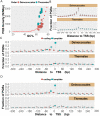Case studies on potential G-quadruplex-forming sequences from the bacterial orders Deinococcales and Thermales derived from a survey of published genomes
- PMID: 30356061
- PMCID: PMC6200779
- DOI: 10.1038/s41598-018-33944-4
Case studies on potential G-quadruplex-forming sequences from the bacterial orders Deinococcales and Thermales derived from a survey of published genomes
Abstract
Genomes provide a platform for storage of chemical information that must be stable under the context in which an organism thrives. The 2'-deoxyguanosine (G) nucleotide has the potential to provide additional chemical information beyond its Watson-Crick base-pairing capacity. Sequences with four or more runs of three G nucleotides each are potential G-quadruplex forming sequences (PQSs) that can adopt G-quadruplex folds. Herein, we analyzed sequenced genomes from the NCBI database to determine the PQS densities of the genome sequences. First, we found organisms with large genomes, including humans, alligators, and maize, have similar densities of PQSs (~300 PQSs/Mbp), and the genomes are significantly enriched in PQSs with more than four G tracks. Analysis of microorganism genomes found a greater diversity of PQS densities. In general, PQS densities positively tracked with the GC% of the genome. Exceptions to this observation were the genomes from thermophiles that had many more PQSs than expected by random chance. Analysis of the location of these PQSs in annotated genomes from the order Thermales showed these G-rich sequences to be randomly distributed; in contrast, in the order Deinococcales the PQSs were enriched and biased around transcription start sites of genes. Four representative PQSs, two each from the Thermales and Deinococcales, were studied by biophysical methods to establish the ability of them to fold to G-quadruplexes. The experiments found the two PQSs in the Thermales did not adopt G-quadruplex folds, while the two most common in the Deinococcales adopted stable parallel-stranded G-quadruplexes. The findings lead to a hypothesis that thermophilic organisms are enriched with PQSs as an unavoidable consequence to stabilize thermally their genomes to live at high temperature; in contrast, the genomes from stress-resistant bacteria found in the Deinococcales may utilize PQSs for gene regulatory purposes.
Conflict of interest statement
The authors declare no competing interests.
Figures






Similar articles
-
Human DNA Repair Genes Possess Potential G-Quadruplex Sequences in Their Promoters and 5'-Untranslated Regions.Biochemistry. 2018 Feb 13;57(6):991-1002. doi: 10.1021/acs.biochem.7b01172. Epub 2018 Jan 24. Biochemistry. 2018. PMID: 29320161 Free PMC article.
-
Intensive Distribution of G₂-Quaduplexes in the Pseudorabies Virus Genome and Their Sensitivity to Cations and G-Quadruplex Ligands.Molecules. 2019 Feb 21;24(4):774. doi: 10.3390/molecules24040774. Molecules. 2019. PMID: 30795541 Free PMC article.
-
Location dependence of the transcriptional response of a potential G-quadruplex in gene promoters under oxidative stress.Nucleic Acids Res. 2019 Jun 4;47(10):5049-5060. doi: 10.1093/nar/gkz207. Nucleic Acids Res. 2019. PMID: 30916339 Free PMC article.
-
Presence, Location and Conservation of Putative G-Quadruplex Forming Sequences in Arboviruses Infecting Humans.Int J Mol Sci. 2023 May 30;24(11):9523. doi: 10.3390/ijms24119523. Int J Mol Sci. 2023. PMID: 37298474 Free PMC article.
-
Colocalization of m6A and G-Quadruplex-Forming Sequences in Viral RNA (HIV, Zika, Hepatitis B, and SV40) Suggests Topological Control of Adenosine N 6-Methylation.ACS Cent Sci. 2019 Feb 27;5(2):218-228. doi: 10.1021/acscentsci.8b00963. Epub 2019 Feb 4. ACS Cent Sci. 2019. PMID: 30834310 Free PMC article. Review.
Cited by
-
Genome-Wide Analysis of Putative G-Quadruplex Sequences (PGQSs) in Onion Yellows Phytoplasma (Strain OY-M): An Emerging Plant Pathogenic Bacteria.Indian J Microbiol. 2019 Dec;59(4):468-475. doi: 10.1007/s12088-019-00831-z. Epub 2019 Oct 8. Indian J Microbiol. 2019. PMID: 31762510 Free PMC article.
-
Structural Studies of Pif1 Helicases from Thermophilic Bacteria.Microorganisms. 2023 Feb 14;11(2):479. doi: 10.3390/microorganisms11020479. Microorganisms. 2023. PMID: 36838444 Free PMC article.
-
Structural mechanism underpinning Thermus oshimai Pif1-mediated G-quadruplex unfolding.EMBO Rep. 2022 Jul 5;23(7):e53874. doi: 10.15252/embr.202153874. Epub 2022 Jun 23. EMBO Rep. 2022. PMID: 35736675 Free PMC article.
-
Whole genome experimental maps of DNA G-quadruplexes in multiple species.Nucleic Acids Res. 2019 May 7;47(8):3862-3874. doi: 10.1093/nar/gkz179. Nucleic Acids Res. 2019. PMID: 30892612 Free PMC article.
-
G-Quadruplex Structures in Bacteria: Biological Relevance and Potential as an Antimicrobial Target.J Bacteriol. 2021 Jun 8;203(13):e0057720. doi: 10.1128/JB.00577-20. Epub 2021 Jun 8. J Bacteriol. 2021. PMID: 33649149 Free PMC article. Review.
References
Publication types
MeSH terms
Substances
Grants and funding
LinkOut - more resources
Full Text Sources
Miscellaneous

